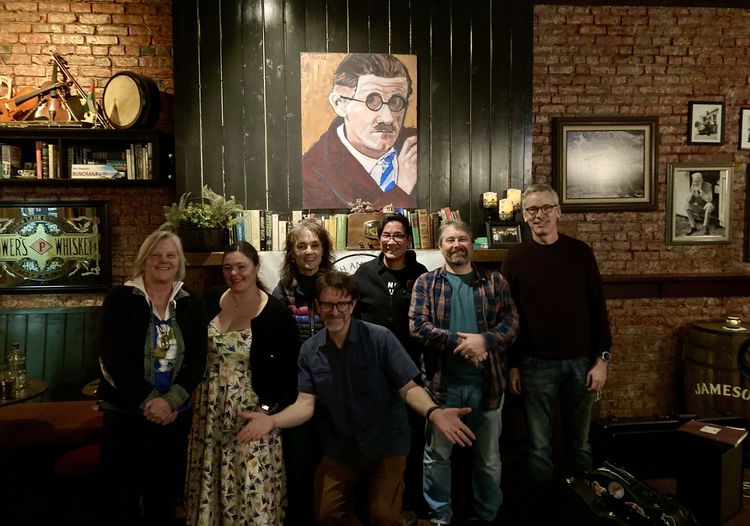At the performance of "Fáinne Óir" were, from left, Daisy Kearns, Maura Mulligan, Unateresa Gormaly, producer Mike Hannon and John Kearns.
By Kevin Phoenix
On last Thursday evening, a delighted audience saw the U.S. premiere of “Fáinne Óir,” a new theatrical experience hailing from County Mayo at the Peter Norton Theatre in Symphony Space.
This production, a unique hybrid of music, dance and dramatic recitation, is the recent creation of composer Kathy Fahey, who along with co-producer Mike Hannon brought to the New York stage for one performance a timeless story of the Irish-American experience five generations in the making.
The story centers around the O'Malley family of Glanageeha, set at the heights of the Great Hunger from 1845-1848 in idyllic West Mayo, and follows the life of the eldest daughter, the aptly named Saoirse, as she journeys from her desolating fate in Ireland to the liberating opportunities of America. Tragedy befalls the O'Malleys after the inconsolable disaster of mother Maire's sudden death, and as the blight of the potato crop threatens incessant demise to their family, father Sean makes the heartbreaking choice to send Saoirse away to New York in the hopes of saving them all.
The “Fáinne Óir” storyline, like many Irish heritage narratives, iterates this version of historical fiction to the hilt: the morbidity and despair of the Famine, the sorrowful separation from Ireland, and the perseverance and persistence, which leads to a happy and successful resolution. The American Dream as old as time, as it were.
Yet unlike its likeminded predecessors, there are a variety of factors that makes this production's interpretation of the Irish-American story so compelling. What makes “Fáinne Óir" one of a kind is the pep of contemporary and modern flair which zests this age-old story in its multi-faceted approach to ambiance and expression.

"Fáinne Óir" at Symphony Space. PADDYRAZZI.COM
The set design is sparse and simple, and artist Padraig McCaul's abstract and curiously cubist artworks, as the sole backdrop of the space, brought an intriguing modernist perspective to the constantly reinventing story of Irish-American progress.
The ambitious music score, performed phenomenally by the Mayo Concert Orchestra, was as complex in its blend of Irish traditional and contemporary classical modes as it was a tremendous treat to hear. Fahey's synthesis of ancient Celtic, conjured by choral group Voxfusion, and the traditional reminiscences, played richly by Diarmaid Moynihan, Stephen Doherty and David Doocey, melded so radiantly with the modern orchestra in a way that perfectly encapsulated the sound of Ireland in the 21st century.
Perhaps above all, the darling factor that literally had audience members jumping out of their seats, was the dance: a hypnotic halfway between Irish dance and contemporary ballet. Choreographed and starring renaissance artist of “Riverdance” fame, Ciara Sexton exceeded all expectations.
Sexton's performance was, in a word, dazzling. The ravishing depths of authenticity and wit which Sexton brought to Saoirse should make her a model of inspiration and confidence to young theatre-goers in her own right, and coupled with the sheer flawlessness–the nimble elegance and emotional profundity of her dance–made her performance an utterly mesmerizing thing to have witnessed.
The show’s narrator was portrayed by Sarah Lafferty in vivid and marvelous form. Lafferty, whose ambidextrous talent will be familiar to many on Irish, British and American stages, delivered a performance of thunderous tenderness in these personal recollections of the narrator; tethering together the show's many elements with a crystalline voice, soaring with speeches of pain, passion and pride.
Much of such accolades can be extended to the rest of the cast, with each individual embodying an exquisite grace and style, not a step out of place.

The show's story begins in County Mayo. PADDYRAZZI.COM
The titular namesake, the Irish-language words for "gold ring," refers to Maire’s wedding ring that in the tearful climax of act one Sean painfully pawns so to afford Saoirse a chance at a better life. The gold ring takes on a symbolism of eternal unity: death and life, poverty and prosperity, leaving and returning to Ireland--if not geographically, then at least in one's heart, in love, and in family.
“Fáinne Óir" is a tale of love, grief, loss, determination, and the joy of reunion, culminating in a marriage of past and present: old and new Ireland together in the land of the free. This show is sure to tug your heartstrings and wrap you around its finger like a fáinne óir.








